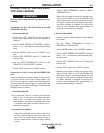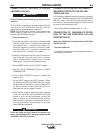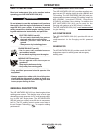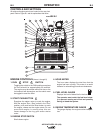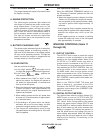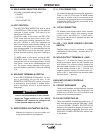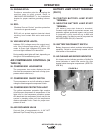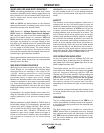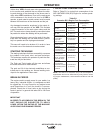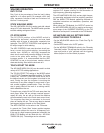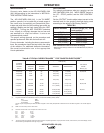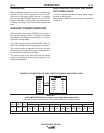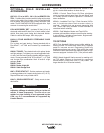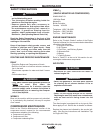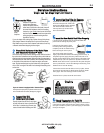
%&(*%$
Unlike other ,(YD Lincoln uses micro processor con-
trol to monitor and establish the arc without the stick-
ing and shorting of the electrode to the job as seen in
many other ,( installations. Due to the requirement
of the resistance in the circuit to be low, for a ,( to
operate, a good metal-to-metal contact must be made
between the metal core of the electrode and the job.
Any damaged connection anywhere in the output cir-
cuit may limit the operation of the ,(. This includes
a good connection of the work return clamp and the
job. The work return clamp should be connected close
as practical to where the welding will be performed.
Some electrodes form a cone at the end of the elec-
trode after the welding arc has been broken, particu-
larly iron powder and low hydrogen electrodes.
This cone will need to be broken off in order to have
the metal core of the electrode to make contact.
)*(*$*$'+
The starting technique that has successfully overcome
the problem is the push, twist, and peel technique.
This technique requires the operator to push the elec-
trode into the joint and twist.
The Push and Twist breaks off the cone and allows
the metal electrode to make contact.
The peel and lift of the electrode establishes a con-
trolled start to the welding arc. Normal welding tech-
nique for the application is then used.
(!$&(%
The engine used to supply power for your welder is a
heavy duty, industrial engine. It is designed and built
for rugged use. It is very normal for any engine to use
small quantities of oil until the break-in is accom-
plished. Check the oil level twice a day during the
break-in period. In general this takes 50 to 100 hours
of operation.
#&%(*$*
$%((*%%#&")*)(!$*
+$* )%+" )+ * *% ,/
"%)-*$*(*$%*#$
,%"%$"(+$$$&(%)
*/&"+"%$)+#&*%$
Refer to Table B.1 for typical fuel consumption of the
AIR VANTAGE® 500 (AU) Engine for various operat-
ing settings.
(,$*Q+
$%* This data is for reference only. Fuel consumption is
approximate and can be influenced by many factors, includ-
ing engine maintenance, environmental conditions and fuel
quality.
*23=6
F>>:?D?8:?6F6=@?DF>AE:@?
Cummins B3.3 Running Time for
56HP(42Kw) 25GAL.(94.6L)
@1800 RPM (Hours)
Low Idle - .59 Gal./hour 42.4
no load 1425 RPM (2.2 L/hour)
High Idle - .87 Gal./hour 28.7
no load 1900 RPM (3.3 L/hour)
DC CC Weld 2.10 Gal./hour 11.9
Output 500 (7.9 L/hour)
Amps @ 40 Volts
Auxiliary Power 1.44 Gal./hour 17.4
12,000 VA (5.5 L/hour)
Air Compressor 1.29 Gal./hour 19.4
60 CFM @ 100 PSI (4.9 L/hour)
Air Compressor
60 CFM @ 100 PSI 2.46 Gal./hour 10.2
and DC, CC Weld (9.3 L/hour)
Output 500 Amps
@40 Volts
Air Compressor
60 CFM @ 100 PSI 1.94 Gal./hour 12.9
and Auxiliary Power (7.3 L/hour)
12,000 VA



